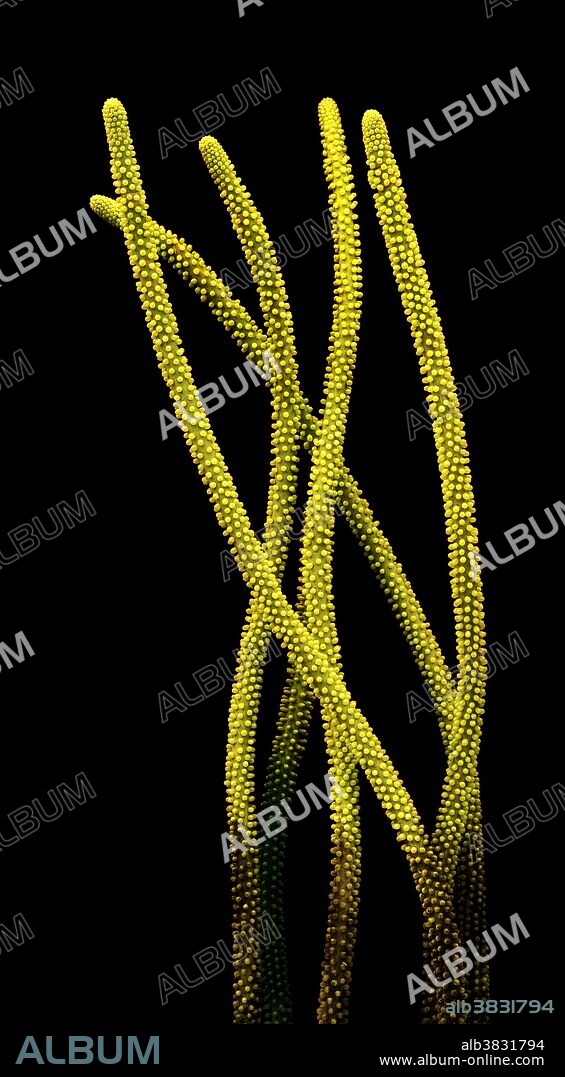alb3831794
Burgess Shale algae

|
Add to another lightbox |
|
Add to another lightbox |



Buy this image.
Select the use:

Title:
Burgess Shale algae
Caption:
Reconstruction of the dasycladacean algae, Margaretia dorus, from the Middle Cambrian Burgess Shale of British Columbia. This alga was recognized by Charles Walcott in the early 1900s as being cylindrical like a sea whip, but later workers described it as having strap-shaped, kelp-like fronds. After examining specimens in the Smithsonian collection, Terry Chase recognized it as a primitive, cylindrical dasycladacean algae whose spiraling arrangement of holes were attachment points for bead-like branches that projected perpendicularly from the central stalk. Though the side branches were not obvious in the Burgess Shale specimens, this concept was adopted for an exhibit reconstruction of the Burgess Shale biota for the Smithsonian. Specimens later recovered from the Middle Cambrian Wheeler Shale of Utah confirmed Chase's speculation. They are cylindrical with beautifully preserved bead-like projections from each hole. Similar algae, like Rhabdoporella from the basal Ordovician of Texas, display a similar structure. Silurian limestones in Sweden are composed almost entirely of these cylindrical dasycladaceans.
Category:
Geology & Fossils
Credit:
Album / Science Source / Chase Studio
Releases:
Image size:
3315 x 6010 px | 57.0 MB
Print size:
28.1 x 50.9 cm | 11.1 x 20.0 in (300 dpi)
Keywords:
ALGA • ALGAE • ANIMAL FOSSIL • ANIMAL FOSSILS • ANIMAL • ANIMALS • BRITISH COLUMBIA • BRITISH COLUMBIAN • BURGESS SHALE FORMATION • BURGESS SHALE FOSSIL • BURGESS SHALE FOSSILS • BURGESS SHALE • BURGESS • CAMBRIAN PERIOD • CAMBRIAN • CANADA • DASYCLADACEAN ALGA • DASYCLADACEAN ALGAE • DASYCLADACEAN • DASYCLADACEANS • EXTINCT ANIMAL • EXTINCT ANIMALS • EXTINCT • EXTINCTION • FAUNA • FOSSIL ANIMAL • FOSSIL ANIMALS • FOSSIL • FOSSILIZED • FOSSILS • GEOLOGY & FOSSILS • ILLUSTRATED • ILLUSTRATION • ILLUSTRATIONS • ILUSTRATION • MARGARETIA DORUS • MARGARETIA • MIDDLE CAMBRIAN PERIOD • MIDDLE CAMBRIAN • PAINTING • PAINTINGS • PALEOZOIC ERA • PALEOZOIC • PREHISTORIC ANIMAL • PREHISTORIC ANIMALS • PREHISTORIC • PREHISTORY • RECONSTRUCTION • RECONSTRUCTIONS • SEAWEED • WILDLIFE


 Pinterest
Pinterest Twitter
Twitter Facebook
Facebook Copy link
Copy link Email
Email
